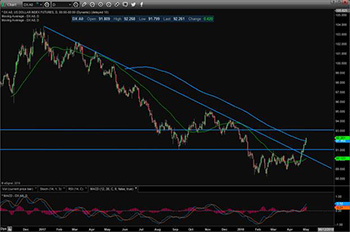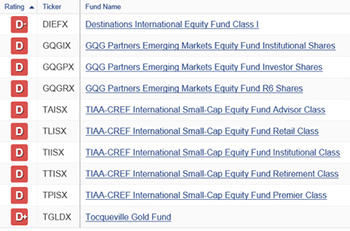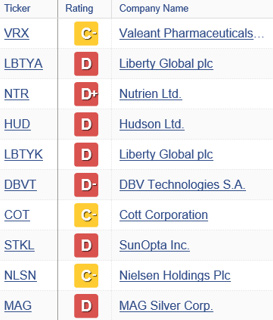The Dollar’s Dog Days are Over; Here’s Who Stands to Lose!
The buck has been a bust since 2016. But the dollar’s dog days are coming to an end — and that’s going to be a HUGE problem for many investments. Investments you may own.
Not only that, but the dollar’s upside reversal could also put another dagger in the bull market’s heart. That means it’s time to make some urgent adjustments to your portfolio (if you haven’t already taken my advice to do so!)
Let’s start with a chart. It shows U.S. Dollar Index (DXY) futures. The index tracks the value of the greenback against six major world currencies, with the euro most heavily weighted at 57.6%, followed by the Japanese yen at 13.6%. Next up is the British pound at 11.9%, with the remainder of the index comprised of the Canadian dollar, Swedish krona, and Swiss franc.
 |
|
Click image for a larger view. |
You can see that the buck started getting blasted back in December 2016. The DXY topped out at around 104, then proceeded to collapse to 88-and-change.
Not entirely coincidentally, the S&P 500 ramped higher during that exact same timeframe. Two reasons: A falling dollar makes U.S. goods more competitive on the world market, while also boosting the value of sales and profits generated overseas.
But it’s clear that momentum is shifting again. The DXY has already jumped three points in a virtual straight line, breaking above a 16-month downtrend and the 200-day moving average. And it isn’t just leapfrogging the major developed world currencies. It’s also trouncing several emerging market currencies the DXY doesn’t contain.
So, what does a rising dollar mean to you? Well, look at how much the S&P 500 rose in 2017 when the U.S. dollar declined. Is it such a stretch to think, then, that a rising dollar will hurt the stock market? I sure don’t think so.
It’s also coming at the same time the IMF is sounding major warnings about the global economy, the major financial stocks are fading fast, and the risk of an “Everything Bust” is soaring.
A rising dollar can also hurt the performance of any mutual funds and ETFs you hold that own foreign assets, as well as U.S.-traded shares of foreign companies. That’s because the value of those foreign assets declines in dollar terms as the buck rises.
My advice?
1. If you haven’t already reduced your stock exposure, don’t wait any longer. This market was already on thin ice, and a rising dollar isn’t going to make things any easier. Only you can determine exactly how much stock to sell. But I told you what I did recently, so take that for what it’s worth.
2. If you own mutual funds or ETFs that invest in foreign markets, lighten up. This dollar move looks like it has legs, and the currency translation effect I mentioned earlier is going to hurt their performance.
 |
|
Click image for a larger view. Data Date: May 1, 2018 |
Need help getting started? Here’s a table showing the lowest-rated mutual funds in our Weiss Ratings database that invest at least 70% of their assets in non-U.S. stocks. I restricted my screen so it would only show funds with negative year-to-date returns and assets of at least $500 million.
3. Finally, if you’ve been investing heavily in U.S.-traded shares of foreign companies, it’s time to head for the exits. The dollar’s rally is going to put serious downward pressure on these so-called American Depository Receipts (ADRs).
 |
|
Click image for a larger view. Data Date: May 1, 2018 |
To identify some of the most potentially vulnerable names, I used our Ratings database to produce the table to the right. It shows all ADRs rated “C-” or lower from the major countries whose currencies are in the Dollar Index (I used Germany and France for the euro).
The list excludes those with market capitalizations of less than $250 million, 30-day average trading volume of less than 50,000 shares, and closing prices of less than $5. It’s sorted in ascending order by YTD return.
Bottom line: The falling dollar gave the stock market a nice push higher. But now a rising dollar could shove it right off a cliff! Foreign-focused mutual funds, ETFs, and ADRs like those listed above look the most dangerous, so start cutting the dead weight right away.
Until next time,
Mike Larson
P.S. The MoneyShow Las Vegas is right around the corner, and I’d love to see you there! As a reminder, it runs from May 14–16, 2018 at the Bally’s/Paris Las Vegas hotel complex. I’ll be delivering a solo presentation called “Investors are Doing Everything WRONG (But There’s Still Time for YOU to Get Things Right!)” on Wednesday, May 16 from 6–6:45 p.m. Plus, I’ll be participating in a lunch panel called “Top Stocks to Buy During a Mid-Term Election Year” that same day from 12:35–2 p.m. Attendance is free, but you do have to register. Click here to do so, or call the MoneyShow team at 1-800-970-4355 and tell them you’re attending on my invitation.

